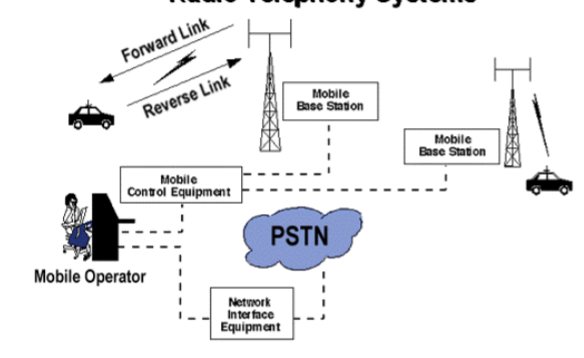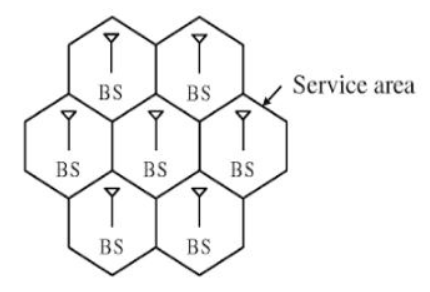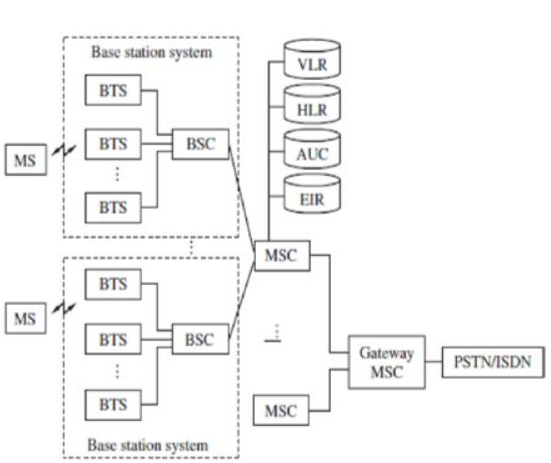Unit-1
Evolution of Mobile Radio Communication Fundamentals
Q1) Explain cellular system components?
A1) The cellular system components are listed below
i) Public Switched Telephone Network (PSTN): It has exchange area network, local networks and long-haul networks that are interconnected to other devices.
Ii) Mobile Telephone Switching Office (MTSO): It has MSC in it. It is the main center office. It has relay station for switching calls to PSTN.
Iii) Cell site with antenna system: It is the location of radio equipment which provides coverage within the cell. It consists of transmitters, receivers and antennas.
Iv) Mobile subscriber unit (MSU): It consists of transceiver which has the task of transmitting and also to receive radio transmission to and from cell site. The mobile telephone, portable and transportable are the types of MSUs.
 Fig 1 Cellular System Components
Fig 1 Cellular System Components
Q2) Explain the directivity of antenna?
A2) An antenna is a device that radiates equally in all directions. AN isotropic radiator is a small area considered. The gain is given as
DBi= Gain compared to isotropic radiator. It has gain 1db
DBd= gain compared to half wave dipole antenna.
The antenna which is not isotropic is directive. Directivity is
D= Maximum received power/Power received if the antenna was isotropic.
D= Pr(maximum)/Pr(isotropic)
Q3) Describe channel assignment strategies?
A3) In Cellular network, channel allocation schemes are required to allocate bandwidth and communication channels to base stations, access points and terminal equipment.
- The objective is to achieve maximum system spectral efficiency in bit/s/Hz/site by means of frequency reuse, but still assure a certain grade of service by avoiding co-channel interference and adjacent channel interference among nearby cells or networks that share the bandwidth.
- The basic concept being that a given geography is divided into polygons called cells.
- Each cell is allocated a portion of the total frequency spectrum. As users move into a given cell, they are then permitted to utilize the channel allocated to that cell. The virtue of the cellular system is that different cells can use the same channel given that the cells are separated by a minimum distance according to the system propagation characteristics; otherwise, intercellular or cochannel interference occurs.
The minimum distance necessary to reduce cochannel interference is called the reuse distance. The reuse distance is defined as the ratio of the distance, D, between cells that can use the same channel without causing interference and the cell radius, R. Note that R is the distance from the center of a cell to the outermost point of the cell in cases when the cells are not circular.
Q4) Draw and explain cellular infrastructure?
A4) The cellular system is replaced by large number of base stations (BS) which are hexagonal cells. They cover certain range of areas.

Fig 2 Cellular Structure
For having the communication in cellular structure, we need Mobile station (MS). In these types of structures, the MS communicates with the BS of cell. This is the location of MS in a BS cell. This BS acts as a gateway. For establishing connections, the MS needs to be in the range of the system. The figure below shows the same.

Fig 3 Cellular system infrastructure
Each base station controller (BSC) consists of MS and a BS. These BSC are then connected to the Mobile switching Centre (MSC). These MSC are then connected to a Public Switch Telephone Network (PSTN) and the Asynchronous Transfer Mode (ATM).
A base station consists of several base transceiver stations (BTS) and a BSC. The antenna and tower are the parts of BTS. The BTS system consists of towers and antennas.

Fig 4 Generic block diagram of cell structure
The Home location register (HLR) is located at MSC. The MS is registered there only in the home location. The visitor location register (VLR) and HLR support mobility and helps to use one number i.e same number anywhere in world. The VLR has information about all MS.
The authentication and encryption are provided by Authentication centre (AUC). The database which provides identity and information about the mobile is equipment identity register (EIR).
Whenever there is a call it is directed to HLR where home MS is registered. This is then forwarded to VLR of MSC where MS is located currently.
Q5) What is frequency reuse?
A5)
It is process of combining analog and digital signal to send over shared medium.
It divides the capacity of communication channel into multiple channels
Multiplexing is divided into space division, frequency division and time division multiplexing.
Space Division Multiplexing
In wired medium, separate point to point conductors are used to each channel.
In wireless medium multiple elements of antennas are used such that it forms phased array antenna.
Multiple output, multiple input and single input multiple output are the examples of this.
Frequency Division Multiplexing
In these multiple signals are send in distinct frequency in single medium.
The signals are electrical.
Radio, television broadcasting are the examples of FDM.
The service provides can send several channels or signals continuously to all subscribers even the customer has single cable connection.
Time Division Multiplexing
In this for separation of data streams the time is used instead of frequency and space.
It consists of group of bits in sequence one after another.
Each sequence is associated with each receiver.
Carriers sense multiple access and multidrug are the examples of time division multiplexing.
Q6) What is Handoff strategy?
A6) If you’re a fan of the Olympics, I am sure you have watched plenty of track events – especially the exciting 400 and 800 meter relays. Four athletes run in each event and hand a baton off to the next athlete until the race is complete. Although the handoffs are usually done without mishap.
When a mobile moves into a different cell while a conversation is in progress, the MSC automatically transfers the call to a new channel belonging to the new base station. This handoff operation not only involves identifying a new base station, but also requires that the voice and control signals be allocated to channels associated with the new base station.
Three strategies have been proposed
- In mobile-controlled handoff (MCHO)
- In network-controlled handoff (NCHO)
- In mobile-assisted handoff (MAHO)
- In mobile-controlled handoff (MCHO)
The MS continuously monitors the signal of surrounding BSs and initiate the handoff process when some handoff criteria are met. MCHO is used in DECT
(Digital Enhanced Cordless Telecommunications)
2. In network-controlled handoff (NCHO)
The surroundings BSs measure the signal from the MS, 7 the network initiates the handoff process when some handoff criteria are met.
3. In mobile-assisted handoff (MAHO)
The network ask the MS to measure the signal from the surrounding BSs. The network makes the handoff decision based on report from the MS. MAHO is used in GSM & IS-95 CDMA
Inter-BS Handoff
In inter-BS handoff, the new & old BSs are connected to same MSC. Assume that the need for handoff is detected by the MS therefor the following actions are to be considered.
- The MS temporarily suspend conversation & initiates the handoff procedure by signalling on free channel in new BS. Then it resumes the conversation on the old BS. As in fig below.
- Upon receipt of the signal, the MCS transfer the encryption information to the selected idle channel of the new BS & set up the new conversation path to the MS through that channel.as in fig below
- After the MS has been transferred to the new BS, it signals the network and resume conversation using the new channel.
- Upon receipt of the handoff completion signal the network removes the bridge from the path and release resources associated with the old channel as in fig below.
This handoff procedure is used with mobile controlled handoff strategy. For network-controlled handoff signalling messages are exchanged between the MS & old BS through the falling link. The whole process is completed as quickly as possible to ensure that new link
Q7) How a cell is sectorized in cellular communication explain?
A7) In this the frequency reuse is increased by reducing number of cells in cluster. The capacity is improved. The CCI is reduced by replacing omni-directional antenna by directional antenna.

Fig 5 120o sectoring
Q8) Explain multipath fading?
A8)
- Multi path causes large and rapid fluctuations in a signal
- These fluctuations are not the same as the propagation path loss.
Multipath causes three major things in wireless communication
- Rapid changes in signal strength over a short distance or time.
- Random frequency modulation due to Doppler Shifts on different multipath signals.
- Time dispersion caused by multipath delays
- These are called “fading effects
Multipath propagation results in small-scale fading.
Q9) What are the types of channel assignment strategies?
A9)
There are two channel assignment strategies in cellular system.
A. Fixed channel assignment:
- In fixed channel assignment each cell is permanently allocated predetermined group of channels. Any call attempt within cell can only be served by unused channels in that particular cell.
- If all channels are occupied, the call is blocked and subscriber does not receive service.
- Borrowing technique where a cell is allowed to borrow channels from a neighbouring cell if all channels are already occupied is always used with this type of strategy. Mobile Base station (MSC) monitors the function of base station including borrowing ensuring that borrowing does not interfere with any call in progress in donor cell.
B. Dynamic channel assignment:
- In dynamic channel assignment strategy, voice channels are not allocated permanently.
- Entire pool of frequency channels lies with MSC and each time a call request is made, the serving base station requests a channel from the MSC. Switch then allocates a channel to the requested cell following a algorithm.
- MSC allocates frequency channels on dynamic basis if that frequency channel is not presently in use in the cell or any other cell which falls within the minimum restricted distance of frequency reuse to avoid co-channel interference.
- It reduces chances of blocking which increases trunking capacity of system as all available channels are accessible to all cells.
- In this MSC has to collect real time data on channel occupancy, traffic distribution, radio signal strength indication of all channels on continuous basis, thus increasing the computational load on MSC.
Q10) Explain general model of communication link?
A10) Mobile computing is an interaction between human and computer by which a computer is expected to be motivating during normal usage. Mobile computing involves software, hardware and mobile communication. Respectively, mobile software deals with the requirements of mobile applications. Also, hardware includes the components and devices which are needed for mobility. Communication issues include ad-hoc and infrastructure networks, protocols, communication properties, data encryption and concrete technologies.
Mobile Computing is a technology that allows transmission of data, voice and video via a computer or any other wireless enabled device without having to be connected to a fixed physical link.
In the last 10 years, the rise of mobile phones as well as laptops has dramatically, increased the availability of mobile devices to businesses and home users. More recently, smaller portable devices such as PDAs and especially embedded devices (e.g. Washing machines, sensors) have slowly changed the way humans live and think of computers.
Mobile computing is associated with the mobility of hardware, data and software in computer applications. The study of this new area of computing has prompted the need to rethink carefully about the way in which mobile network and systems are conceived. Even though mobile and traditional distributed systems may appear to be closely related, there are a number of factors that differentiate the two, especially in terms of type of device (fixed/mobile),network connection (permanent/intermittent) and execution context (static/dynamic)
A cellular or mobile phone is a long range portable electronic device for communication over long distance. Current Mobile Phones can support many latest services such as SMS, GPRS, MMS, email, packet switching, WAP, Bluetooth and many more. Most of the mobile phones connect to the cellular networks and which are further connected with the PSTN (Public switching telephone network). Besides mobile communications, there is a wide range of mobile products available such mobile scanners, mobile printers and mobile labellers.
Conceptually, computing can be seen as: USER ⇔ COMP.SYS ⇔ ENVIRONMENT